- Home
- Medical news & Guidelines
- Anesthesiology
- Cardiology and CTVS
- Critical Care
- Dentistry
- Dermatology
- Diabetes and Endocrinology
- ENT
- Gastroenterology
- Medicine
- Nephrology
- Neurology
- Obstretics-Gynaecology
- Oncology
- Ophthalmology
- Orthopaedics
- Pediatrics-Neonatology
- Psychiatry
- Pulmonology
- Radiology
- Surgery
- Urology
- Laboratory Medicine
- Diet
- Nursing
- Paramedical
- Physiotherapy
- Health news
- Fact Check
- Bone Health Fact Check
- Brain Health Fact Check
- Cancer Related Fact Check
- Child Care Fact Check
- Dental and oral health fact check
- Diabetes and metabolic health fact check
- Diet and Nutrition Fact Check
- Eye and ENT Care Fact Check
- Fitness fact check
- Gut health fact check
- Heart health fact check
- Kidney health fact check
- Medical education fact check
- Men's health fact check
- Respiratory fact check
- Skin and hair care fact check
- Vaccine and Immunization fact check
- Women's health fact check
- AYUSH
- State News
- Andaman and Nicobar Islands
- Andhra Pradesh
- Arunachal Pradesh
- Assam
- Bihar
- Chandigarh
- Chattisgarh
- Dadra and Nagar Haveli
- Daman and Diu
- Delhi
- Goa
- Gujarat
- Haryana
- Himachal Pradesh
- Jammu & Kashmir
- Jharkhand
- Karnataka
- Kerala
- Ladakh
- Lakshadweep
- Madhya Pradesh
- Maharashtra
- Manipur
- Meghalaya
- Mizoram
- Nagaland
- Odisha
- Puducherry
- Punjab
- Rajasthan
- Sikkim
- Tamil Nadu
- Telangana
- Tripura
- Uttar Pradesh
- Uttrakhand
- West Bengal
- Medical Education
- Industry
New technique uses vortex ultrasound to break down blood clots in cerebral venous sinus thrombosis: Study

USA: A new technique called vortex ultrasound thrombolysis could be a new life-saving tool for patients with severe cerebral venous sinus thrombosis (CVST) who cannot be treated effectively using existing therapies, according to researchers.
Researchers have developed a new tool and technique that uses “vortex ultrasound” -a sort of ultrasonic tornado-to break down blood clots in the brain. The new approach worked faster than existing techniques to eliminate clots formed in an in vitro cerebral venous sinus thrombosis model.The preliminary testing of ultrasound "tornado" has shown promising results for treatment of acute blood clots in patients with a cerebral venous sinus thrombosis (CVST).
“Our previous work looked at various ultrasound techniques to eliminate blood clots using what are essentially forward-facing waves,” says Xiaoning Jiang, co-corresponding author of a paper on the work. “Our new work uses vortex ultrasound, where the ultrasound waves have a helical wavefront.
“In other words, the ultrasound is swirling as it moves forward,” says Jiang, Dean F. Duncan Professor of Mechanical and Aerospace Engineering at North Carolina State University. “Based on our in vitro testing, this approach eliminates blood clots more quickly than existing techniques, largely because of the shear stress induced by the vortex wave.”
“The fact that our new technique works quickly is important because CVST clots increase pressure on blood vessels in the brain,” says Chengzhi Shi, co-corresponding author of the work and an assistant professor of mechanical engineering at Georgia Tech. “This increases the risk of a hemorrhage in the brain, which can be catastrophic for patients.
“Existing techniques largely rely on interventions that dissolve the blood clot. But this is a time-consuming process. Our approach can potentially address these clots more quickly, reducing patient risk.”
CVST occurs when a blood clot forms in the veins responsible for draining blood from the brain. Incidence rates of CVST were between 2 and 3 per 100,000 in the United States in 2018 and 2019, and the incidence rate appears to be increasing.
“Another reason our work here is important is that current treatments for CVST fail in 20-40% of cases,” Jiang says.
The new tool consists of a single transducer specifically designed to produce the swirling vortex effect. The transducer is small enough to be incorporated into a catheter, which is then fed through the circulatory system to the blood clot site.
For proof-of-concept in vitro testing, the researchers used cow blood in a 3D-printed model of the cerebral venous sinus.
“Based on available data, pharmaceutical interventions to dissolve CVST blood clots take at least 15 hours and average around 29 hours,” Shi says. “During in vitro testing, we could dissolve an acute blood clot in under half an hour.”
During any catheterization or surgical intervention, there is a potential risk of harm, such as damaging the blood vessel. To address this issue, the researchers performed experiments applying vortex ultrasound to animal blood vein samples. Those tests found no damage to the walls of the blood vessels.
The researchers also tested whether the vortex ultrasound caused significant damage to red blood cells. They found that there was no substantial damage to red blood cells.
“The next step is for us to perform tests using an animal model better to establish the viability of this technique for CVST treatment,” Jiang says. “If those tests are successful, we hope to pursue clinical trials.”
“And if the vortex ultrasound ever becomes a clinical application, it would likely be comparable in cost to other interventions used to treat CVST,” says Shi.
Reference:
Bohua Zhang, Huaiyu Wu, Howuk Kim, Phoebe J. Welch, Ashley Cornett, Greyson Stocker, Raul G. Nogueira, Jinwook Kim, Gabe Owens, Paul Dayton, Zhen Xu, Chengzhi Shi, RESEARCH DOI: 10.34133/research.0048
Dr Kamal Kant Kohli-MBBS, DTCD- a chest specialist with more than 30 years of practice and a flair for writing clinical articles, Dr Kamal Kant Kohli joined Medical Dialogues as a Chief Editor of Medical News. Besides writing articles, as an editor, he proofreads and verifies all the medical content published on Medical Dialogues including those coming from journals, studies,medical conferences,guidelines etc. Email: drkohli@medicaldialogues.in. Contact no. 011-43720751


